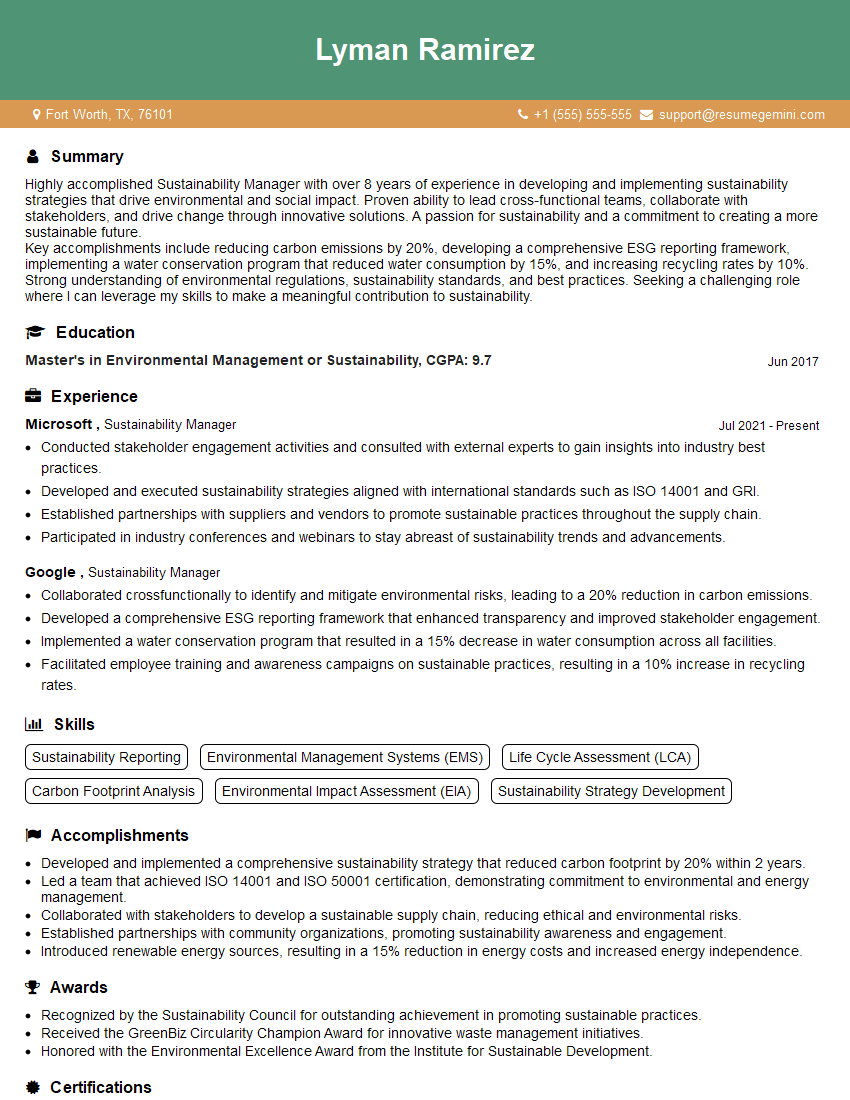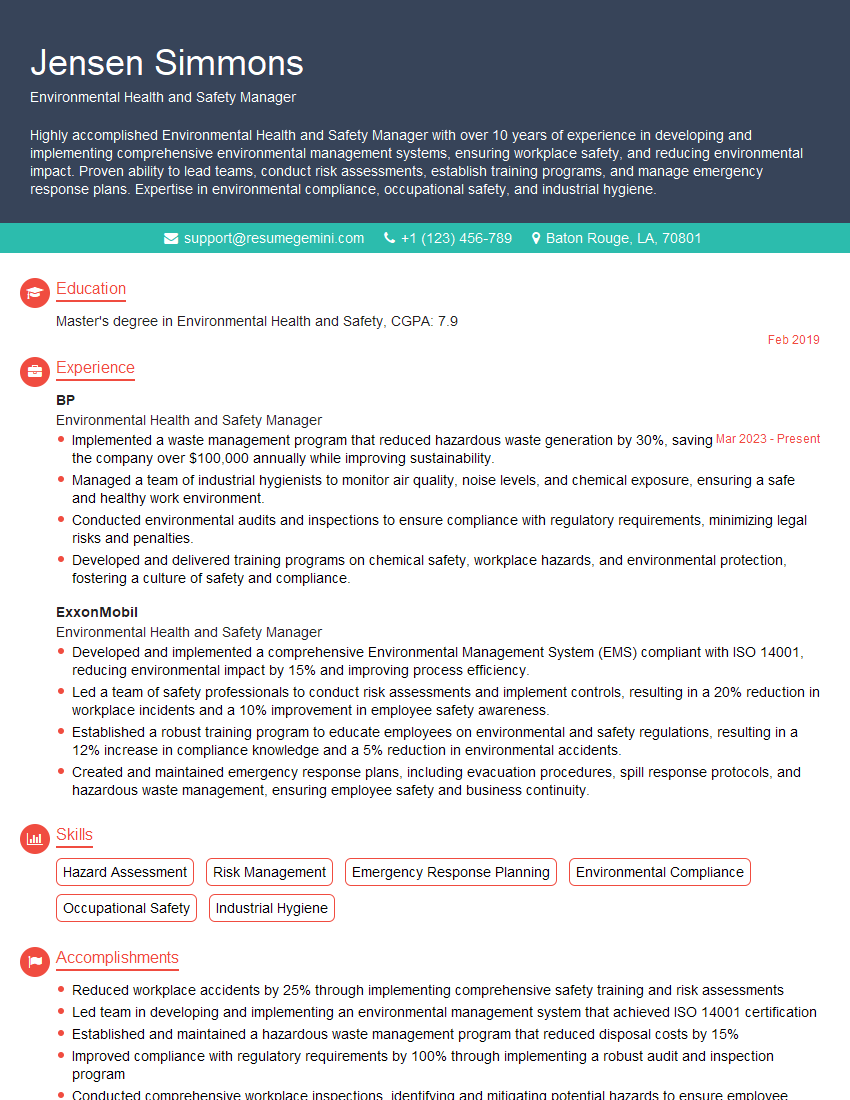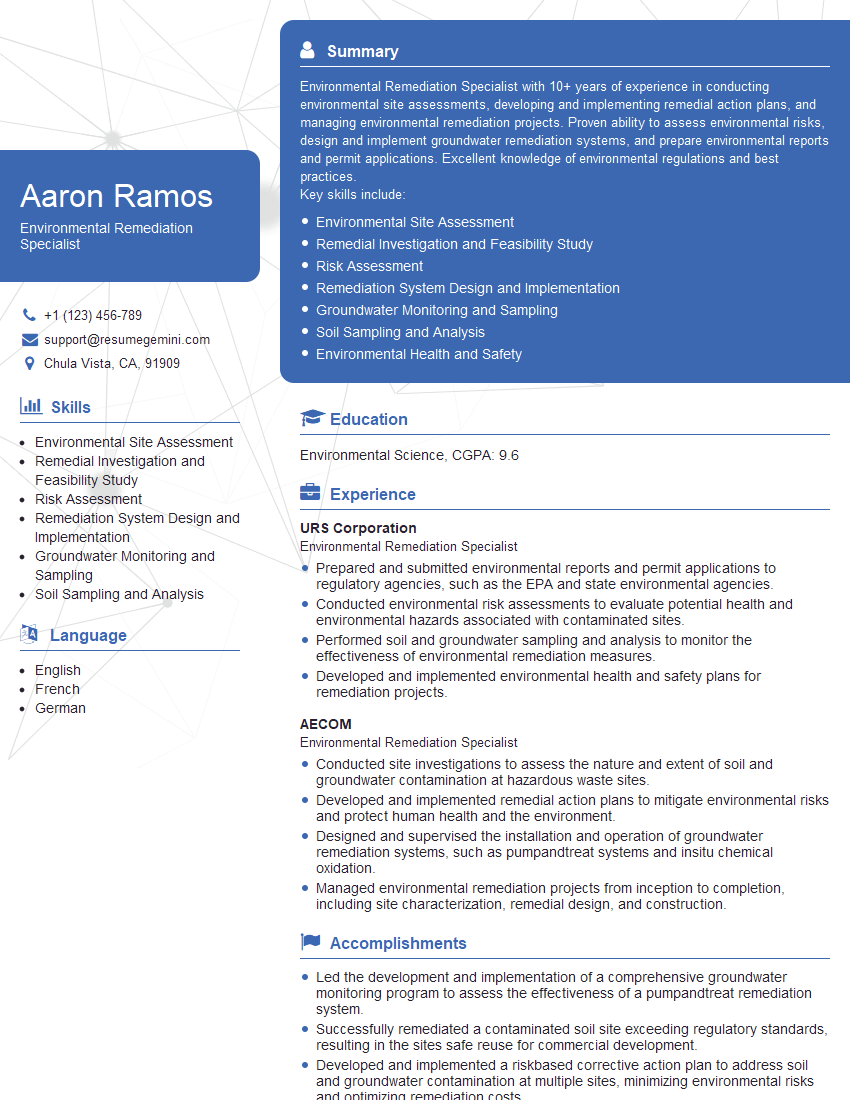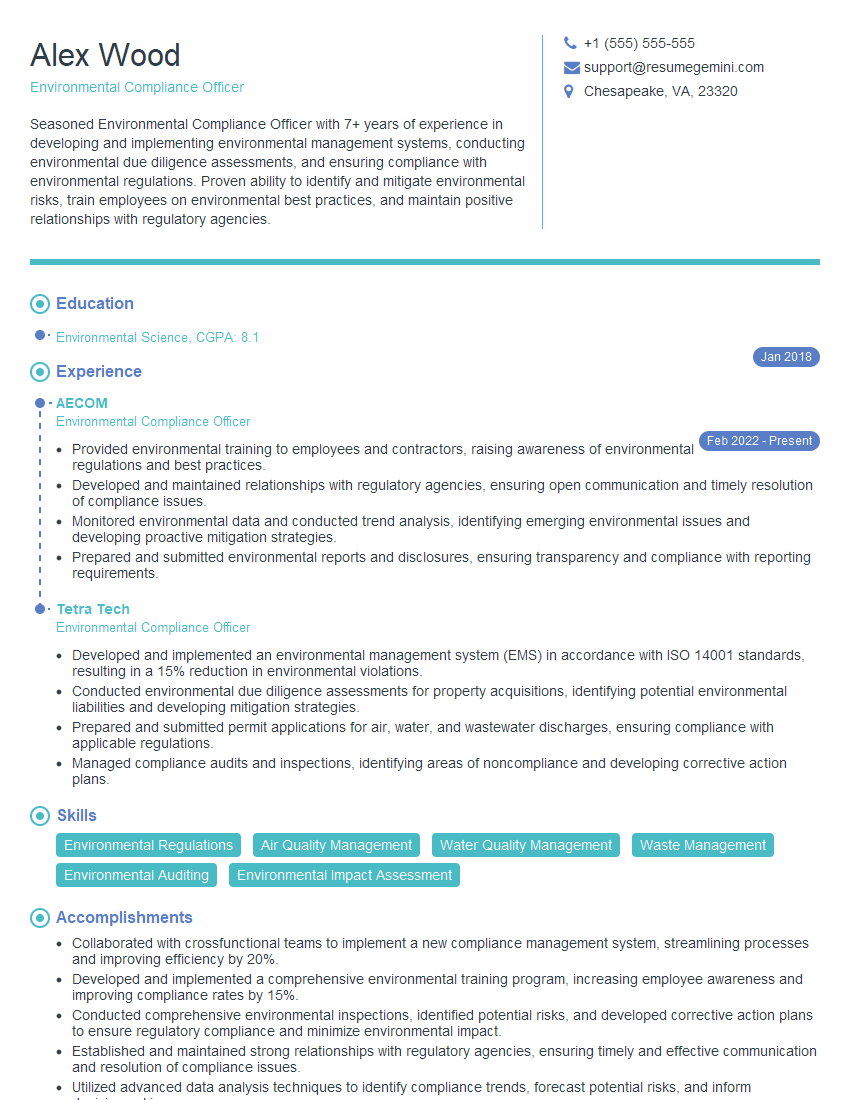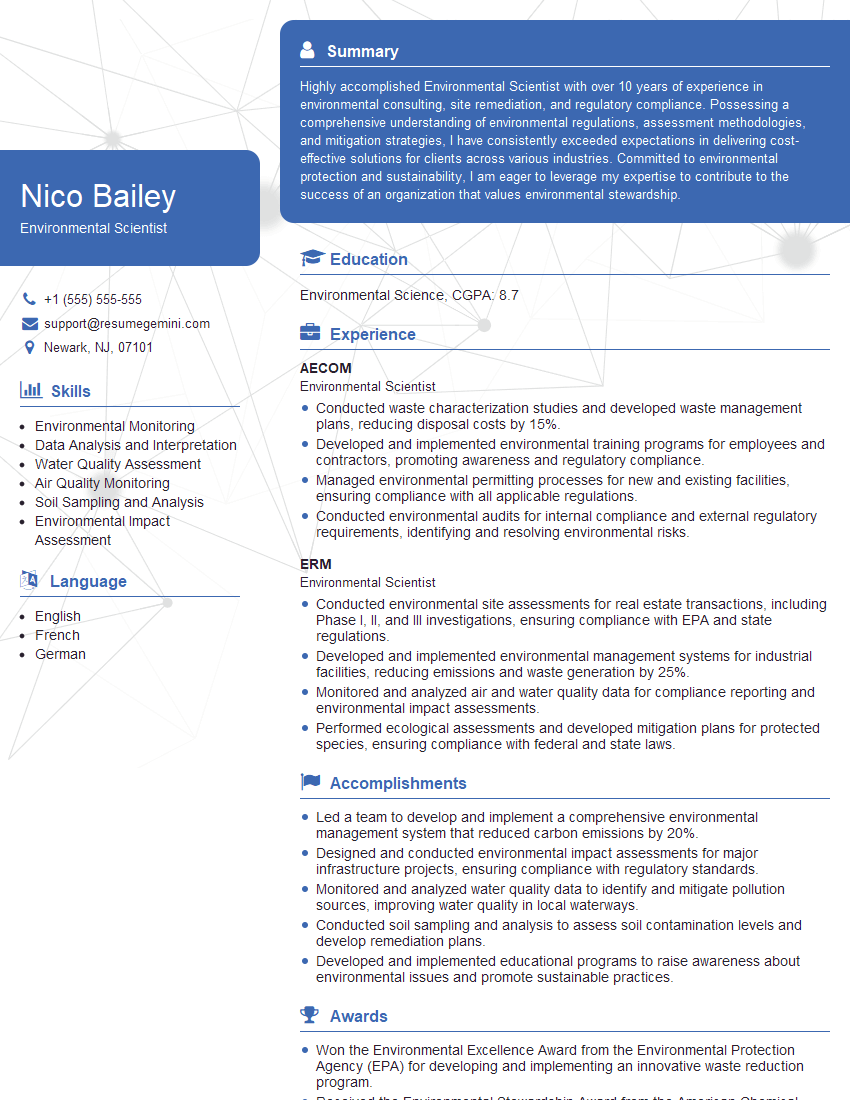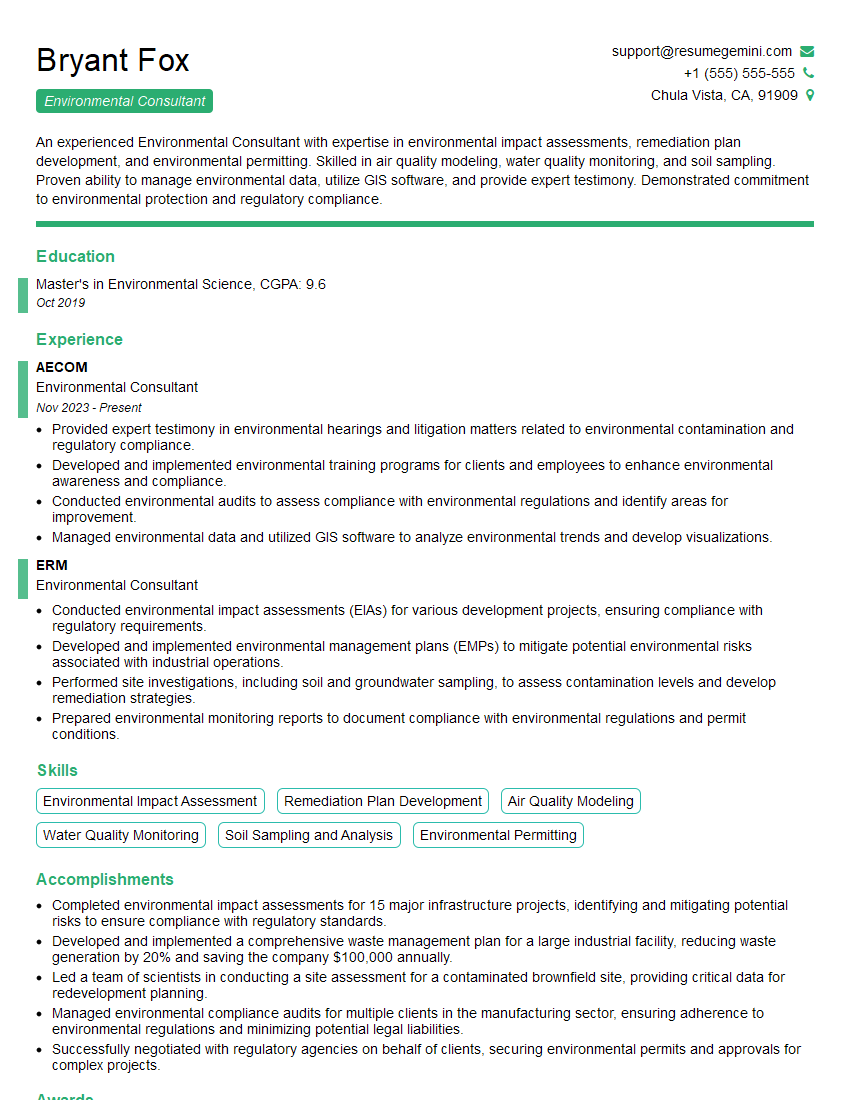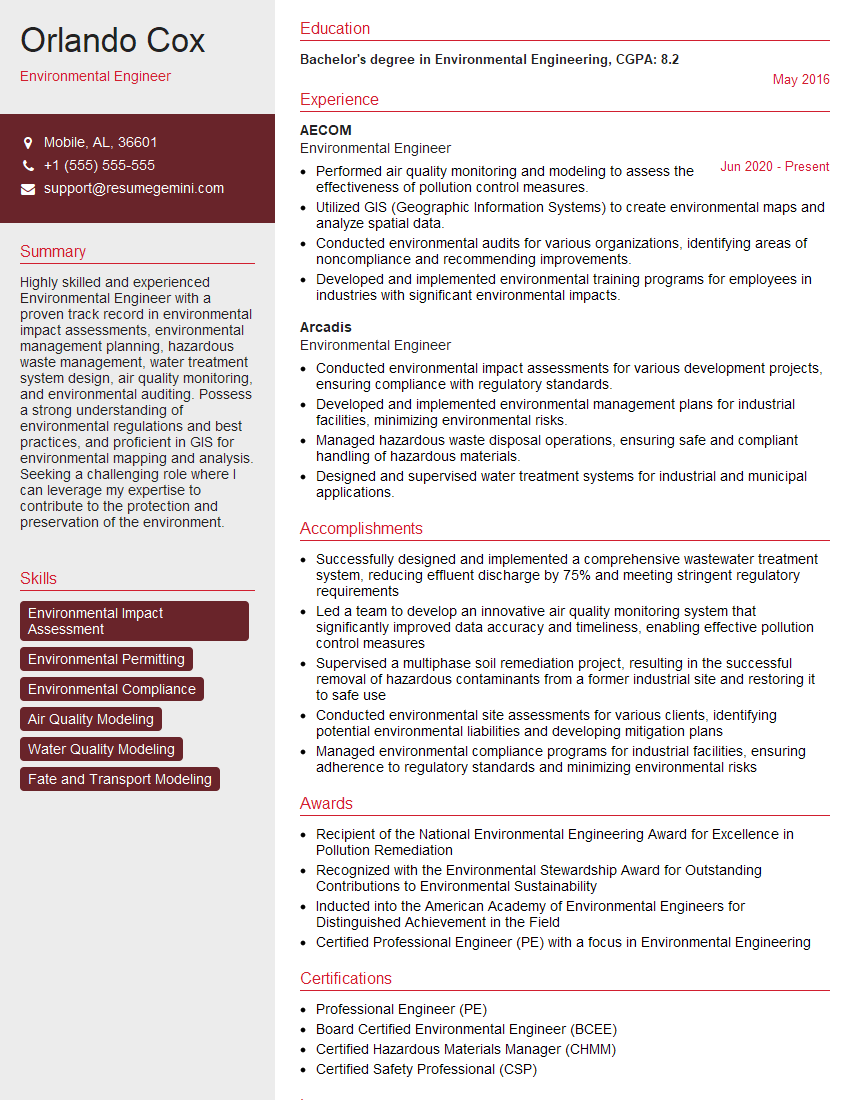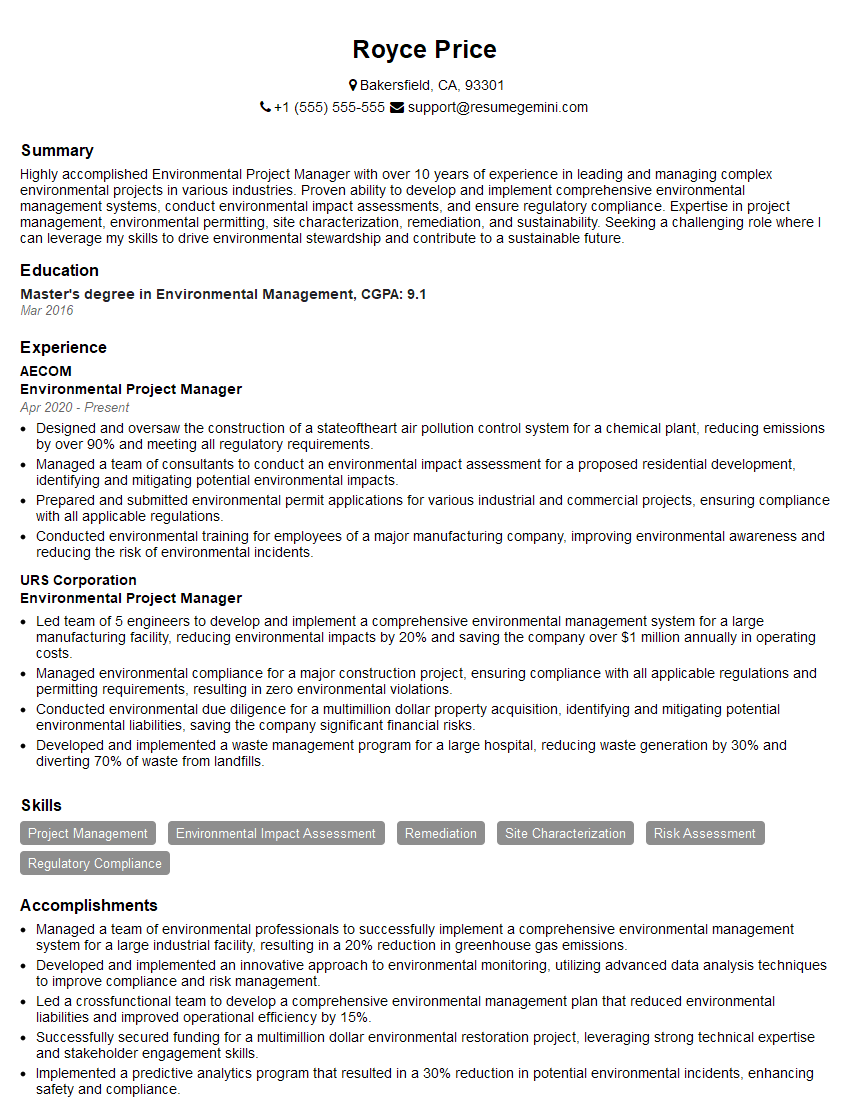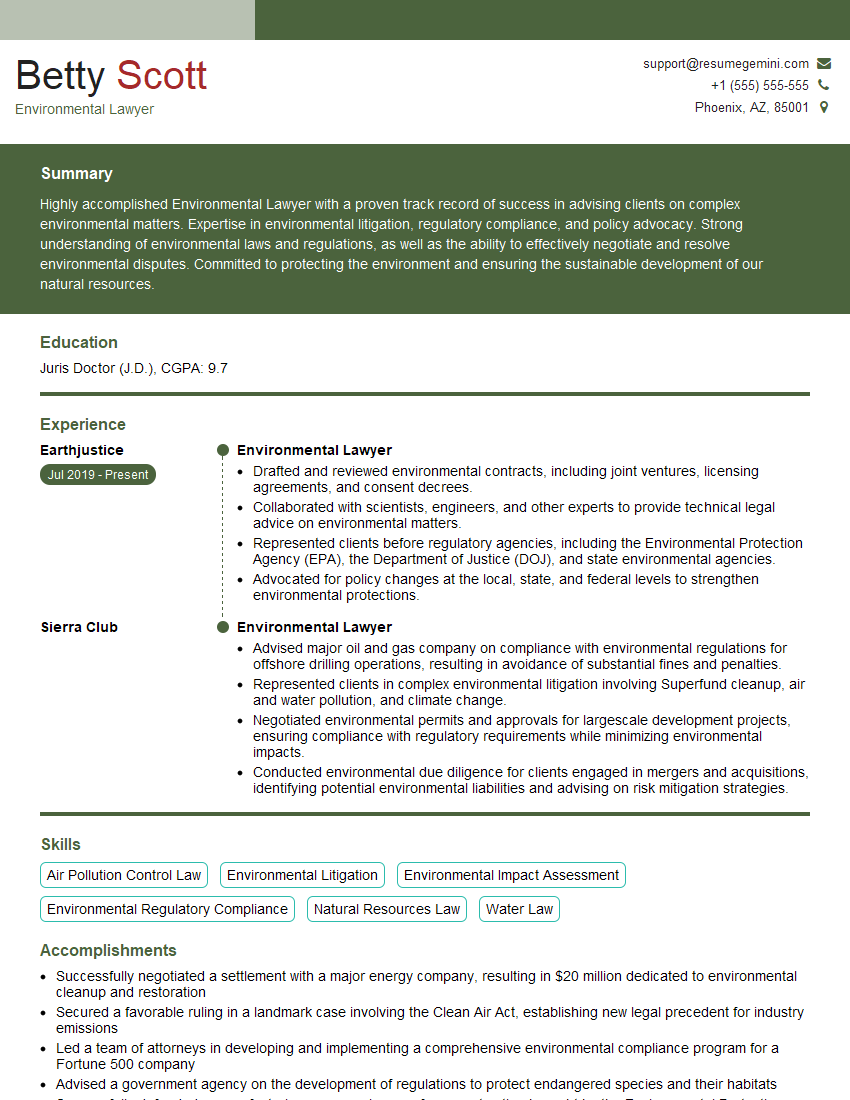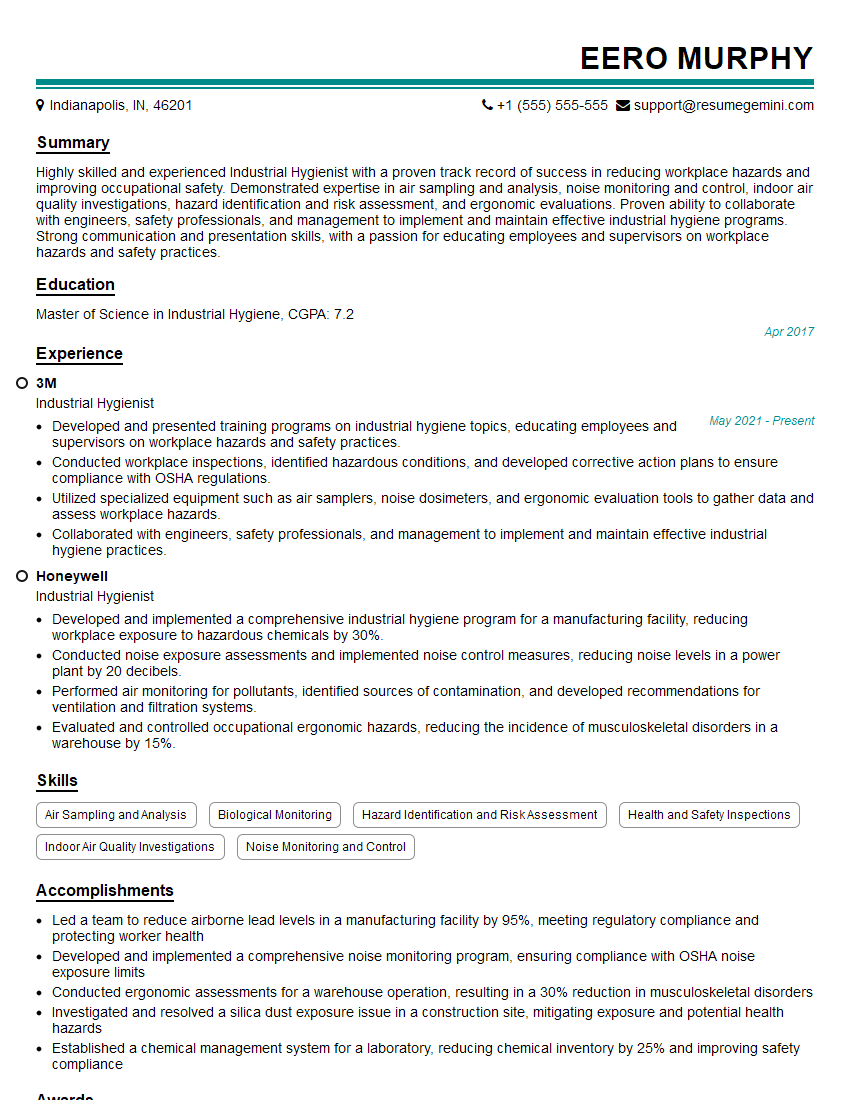Are you ready to stand out in your next interview? Understanding and preparing for Environmental Risk Management and Mitigation Planning interview questions is a game-changer. In this blog, we’ve compiled key questions and expert advice to help you showcase your skills with confidence and precision. Let’s get started on your journey to acing the interview.
Questions Asked in Environmental Risk Management and Mitigation Planning Interview
Q 1. Describe your experience conducting environmental risk assessments.
Environmental risk assessments are systematic processes to identify, analyze, and evaluate potential environmental impacts associated with a project, activity, or facility. My experience spans various sectors, including industrial manufacturing, infrastructure development, and resource extraction. I’ve utilized a range of methodologies, from qualitative screening assessments to quantitative risk modeling, tailored to the specific context and available data. For instance, in a recent assessment for a proposed wind farm, we used GIS mapping to identify potential impacts on bird migration routes and then employed a quantitative model to estimate the probability and severity of bird collisions. Another project involved assessing the risk of soil and groundwater contamination at a former industrial site, which required extensive site investigation, sampling, and laboratory analysis, coupled with fate and transport modeling.
My approach always includes stakeholder engagement, ensuring that diverse perspectives are considered, and clear communication of findings and recommendations. I’m proficient in using various software tools for data analysis and visualization, creating reports that are both technically sound and easily understood by a non-technical audience.
Q 2. Explain the process of developing a mitigation plan for an identified environmental risk.
Developing a mitigation plan is a crucial step after identifying environmental risks. It’s a structured process aimed at minimizing or eliminating identified risks, ensuring compliance with regulations, and promoting environmental sustainability. The process generally involves:
- Prioritization: Ranking risks based on likelihood and severity (discussed further in question 4).
- Mitigation Strategy Selection: Choosing appropriate measures to control or reduce the identified risks. These might include engineering controls (e.g., installing pollution control equipment), administrative controls (e.g., implementing stricter operating procedures), or operational changes (e.g., altering production processes).
- Implementation Planning: Outlining a detailed plan for implementing the chosen mitigation strategies, including timelines, responsibilities, and resource allocation.
- Monitoring and Evaluation: Establishing a system to monitor the effectiveness of the mitigation measures. Regular monitoring allows for adjustments if necessary, ensuring the plan remains effective.
- Documentation: Maintaining thorough records of all aspects of the risk assessment and mitigation planning process.
For example, if a risk assessment reveals a high likelihood of water pollution from a manufacturing facility, mitigation strategies might include installing a wastewater treatment plant, implementing regular water quality monitoring, and developing emergency response plans for spills.
Q 3. What are the key elements of a successful environmental management system (EMS)?
A successful Environmental Management System (EMS) is the backbone of a company’s commitment to environmental responsibility. Key elements include:
- Environmental Policy: A formal statement of the organization’s environmental commitment and objectives.
- Planning: Establishing environmental objectives and targets, identifying legal and regulatory requirements, and assessing environmental aspects and impacts.
- Implementation and Operation: Putting the EMS into practice, including resource allocation, training, and communication.
- Monitoring and Measurement: Tracking performance against objectives and targets, identifying areas for improvement.
- Review: Regularly reviewing the EMS’s effectiveness and making necessary adjustments.
- Continual Improvement: A commitment to ongoing improvement in environmental performance.
An effective EMS isn’t merely a set of procedures; it’s a holistic approach integrated into the organization’s culture, driving continuous improvement and fostering environmental stewardship. ISO 14001 provides a widely recognized framework for establishing and implementing an EMS.
Q 4. How do you prioritize environmental risks based on likelihood and consequence?
Risk prioritization is crucial in environmental management. We use a matrix approach that considers both the likelihood of an event occurring and the severity of its consequences. Typically, this is represented visually:
Likelihood (Low, Medium, High) x Severity (Low, Medium, High) = Risk Level (Low, Medium, High)
A risk matrix is created, mapping likelihood against severity. For example:
- Low Likelihood, Low Severity: Low Risk – Minimal action required. Monitor only.
- High Likelihood, Low Severity: Medium Risk – Implement preventative measures.
- Low Likelihood, High Severity: Medium Risk – Implement contingency plans.
- High Likelihood, High Severity: High Risk – Implement immediate and robust mitigation strategies.
This matrix allows us to focus resources on the most critical risks, ensuring efficient and effective risk management. Quantitative data is incorporated whenever possible, making the assessment more objective. However, qualitative judgements are also necessary, particularly when dealing with less quantifiable risks, such as reputational damage.
Q 5. What are some common environmental regulations and compliance requirements you’ve encountered?
My experience encompasses a wide range of environmental regulations and compliance requirements. Some of the most common include:
- Clean Water Act (CWA): Regulating discharges of pollutants into U.S. waters.
- Clean Air Act (CAA): Controlling air pollution emissions.
- Resource Conservation and Recovery Act (RCRA): Managing hazardous waste generation, transportation, treatment, storage, and disposal.
- Comprehensive Environmental Response, Compensation, and Liability Act (CERCLA or Superfund): Addressing cleanup of hazardous waste sites.
- Endangered Species Act (ESA): Protecting endangered and threatened species and their habitats.
The specific regulations encountered vary significantly depending on the industry, location, and type of activity. I have expertise in navigating these complex regulations, ensuring compliance and minimizing potential legal and financial penalties. This often involves conducting environmental audits, preparing permits and reports, and working with regulatory agencies.
Q 6. How do you identify and evaluate potential environmental liabilities?
Identifying and evaluating potential environmental liabilities is critical for businesses, especially in industries with a history of environmental impacts. This involves a thorough assessment of:
- Past Activities: Reviewing historical operations to identify potential sources of contamination or environmental damage.
- Site Conditions: Conducting site investigations to assess the current state of the environment and identify any existing contamination.
- Regulatory Requirements: Determining whether past activities violated environmental regulations and whether remediation is required.
- Financial Implications: Estimating the costs associated with remediation, penalties, and potential legal actions.
For example, a company considering acquiring an industrial site needs a comprehensive environmental assessment to determine the extent of any existing contamination and the potential financial implications of cleaning it up. This might involve Phase I, II, and sometimes Phase III environmental site assessments, which progressively investigate the level and extent of contamination. The assessment results inform decisions about remediation strategies and liability management.
Q 7. Explain your understanding of life cycle assessment (LCA).
Life Cycle Assessment (LCA) is a comprehensive methodology for evaluating the environmental impacts of a product or service throughout its entire life cycle, from raw material extraction to disposal or recycling. It’s a cradle-to-grave analysis, encompassing various environmental aspects such as:
- Global Warming Potential: Greenhouse gas emissions.
- Ozone Depletion Potential: Impact on the ozone layer.
- Acidification Potential: Contribution to acid rain.
- Eutrophication Potential: Nutrient enrichment of water bodies.
- Resource Depletion: Consumption of non-renewable resources.
LCAs are conducted using standardized methodologies, such as ISO 14040 series, and involve data collection, impact assessment, and interpretation. The results help in identifying opportunities for environmental improvement, guiding product design, and informing purchasing decisions. For example, an LCA of a plastic bottle might compare the environmental impacts of different materials (e.g., recycled PET, biodegradable plastic), manufacturing processes, and end-of-life scenarios (e.g., recycling, incineration, landfill), guiding the choice towards a more sustainable option.
Q 8. Describe your experience with environmental impact assessments (EIAs).
Environmental Impact Assessments (EIAs) are crucial for predicting and evaluating the likely environmental impacts of a proposed project or development. My experience spans numerous EIAs across diverse sectors, including infrastructure projects, mining operations, and renewable energy developments. I’ve been involved in all phases, from scoping and baseline studies to impact prediction, mitigation planning, and the preparation of final EIA reports for regulatory submission. For example, on a recent highway construction project, I led a team that assessed potential impacts on water quality, wildlife habitats, and air quality. This involved detailed field surveys, hydrological modeling, and habitat assessments. The resulting EIA report not only highlighted potential negative impacts but also proposed mitigation measures like creating wildlife corridors and implementing erosion control strategies. This ultimately led to project modifications that significantly reduced its environmental footprint.
Q 9. How do you integrate environmental considerations into project planning and design?
Integrating environmental considerations into project planning and design is not an afterthought; it’s a fundamental aspect of sustainable development. I employ a proactive, lifecycle approach. This begins with early stakeholder engagement to identify potential environmental concerns. Then, I incorporate environmental factors into every stage of the project, from site selection and design to construction and operation. For instance, on a wind farm project, we evaluated site suitability based on bird migration patterns and potential noise impacts on nearby communities. This led to optimized turbine placement and noise mitigation strategies, ensuring minimal environmental disruption. Sustainable material selection, waste management plans, and energy-efficient designs are also key components of my approach. Essentially, environmental sustainability is woven into the project’s DNA, not tacked on as a separate consideration.
Q 10. What are some common environmental auditing methods?
Environmental auditing employs various methods to assess environmental performance. Common methods include:
- Compliance Audits: These verify adherence to environmental regulations and permits. For example, checking for proper waste disposal practices or compliance with air emission limits.
- Management System Audits: These evaluate the effectiveness of environmental management systems (EMS), such as ISO 14001, ensuring processes are in place for continuous improvement.
- Environmental Due Diligence Audits: These assess the environmental liabilities associated with a property or business before a transaction, identifying potential risks and costs.
- Performance Audits: These analyze environmental performance indicators (e.g., energy consumption, waste generation) against targets and benchmarks, identifying areas for improvement.
Q 11. Explain your experience with environmental monitoring and data analysis.
Environmental monitoring and data analysis are crucial for tracking environmental performance and identifying emerging issues. My experience includes designing and implementing monitoring programs, collecting data (water quality, air quality, noise levels, etc.), and performing statistical analysis to interpret results. For example, on a remediation project, I oversaw groundwater monitoring to track the effectiveness of the cleanup efforts. We used statistical process control (SPC) techniques to detect trends and anomalies in the data, ensuring the remediation was successful and efficient. Data visualization techniques like GIS mapping were crucial in presenting the complex data in an easily understandable format to stakeholders. Robust data management practices, including quality control and assurance, are integral to ensuring data reliability and the validity of findings.
Q 12. How do you communicate environmental risks and mitigation strategies to stakeholders?
Communicating environmental risks and mitigation strategies effectively is paramount to successful environmental management. I utilize a multi-faceted approach tailored to the audience. This includes:
- Clear and Concise Reporting: Preparing reports with plain language and visual aids (graphs, maps) to make complex information accessible to non-technical stakeholders.
- Interactive Workshops and Presentations: Facilitating workshops and presentations to engage stakeholders in discussions about risks and mitigation options.
- Stakeholder Engagement Platforms: Utilizing online platforms to disseminate information, collect feedback, and maintain transparency.
- Tailored Communication: Adjusting communication style and content to suit specific stakeholders’ needs and understanding.
Q 13. How do you handle environmental emergencies or incidents?
Handling environmental emergencies or incidents requires a rapid and coordinated response. My approach follows a structured framework:
- Immediate Response: Prioritize human safety and environmental protection. Contain the spill or incident to prevent further damage.
- Assessment and Investigation: Determine the extent of the damage, identify the causes, and collect evidence.
- Emergency Response Plan Activation: Implement pre-established emergency response plans, notifying relevant authorities and stakeholders.
- Remediation and Cleanup: Initiate cleanup and restoration activities, using appropriate technologies and techniques.
- Post-Incident Review: Conduct a thorough post-incident review to identify lessons learned and improve future prevention and response strategies.
Q 14. Describe your experience with environmental remediation projects.
Environmental remediation projects aim to clean up contaminated sites. My experience involves various remediation techniques, including:
- Soil Remediation: Techniques like bioremediation (using microorganisms to break down contaminants), soil washing, and thermal desorption.
- Groundwater Remediation: Methods like pump and treat, in-situ bioremediation, and permeable reactive barriers.
- Air Remediation: Techniques such as filtration, adsorption, and catalytic oxidation.
Q 15. What are some key performance indicators (KPIs) used to measure environmental performance?
Key Performance Indicators (KPIs) are crucial for tracking environmental performance and demonstrating progress towards sustainability goals. They provide quantifiable metrics to assess effectiveness and identify areas for improvement. The specific KPIs used will vary depending on the organization and its industry, but some common examples include:
- Greenhouse Gas (GHG) emissions: Measured in tons of CO2e (carbon dioxide equivalent), this KPI tracks the organization’s contribution to climate change. A reduction in GHG emissions is a key target for many companies.
- Energy consumption: Measured in kilowatt-hours (kWh) or other relevant units, this KPI monitors energy efficiency and identifies opportunities for conservation. This can be broken down by source (e.g., electricity, natural gas) to pinpoint specific areas of high consumption.
- Waste generation: Measured in tons or kilograms, this KPI tracks the amount of waste produced and helps assess waste reduction efforts. Tracking different waste streams (e.g., hazardous, recyclable) provides a more nuanced picture.
- Water consumption: Measured in liters or gallons, this KPI tracks water usage and highlights areas where water conservation measures can be implemented. This is particularly important in water-stressed regions.
- Compliance incidents: This KPI tracks the number of environmental compliance violations. A low number indicates strong adherence to regulations.
- Environmental remediation costs: Tracking spending on environmental cleanup and remediation projects helps evaluate the financial impact of environmental liabilities and the effectiveness of mitigation efforts.
Effective KPI selection involves considering materiality (relevance to the business and stakeholders), feasibility (ability to accurately measure), and alignment with overarching environmental goals. Regular monitoring and reporting on these KPIs are crucial for driving continuous improvement.
Career Expert Tips:
- Ace those interviews! Prepare effectively by reviewing the Top 50 Most Common Interview Questions on ResumeGemini.
- Navigate your job search with confidence! Explore a wide range of Career Tips on ResumeGemini. Learn about common challenges and recommendations to overcome them.
- Craft the perfect resume! Master the Art of Resume Writing with ResumeGemini’s guide. Showcase your unique qualifications and achievements effectively.
- Don’t miss out on holiday savings! Build your dream resume with ResumeGemini’s ATS optimized templates.
Q 16. How do you stay updated on current environmental regulations and best practices?
Staying current with environmental regulations and best practices is paramount in environmental risk management. My approach is multi-faceted:
- Subscription to specialized databases and publications: I regularly access resources like those provided by the Environmental Protection Agency (EPA), industry-specific associations, and legal databases, to access the most up-to-date information on regulations and emerging trends.
- Professional development and networking: I actively participate in conferences, workshops, and training programs focused on environmental management to engage with experts and learn about new developments. Networking with peers allows for sharing of best practices and insights.
- Monitoring relevant government websites and agencies: I regularly check the websites of relevant regulatory bodies for updates on legislation, guidance documents, and enforcement actions. This proactive approach helps me anticipate potential changes and their impact.
- Utilizing industry-specific news and journals: I subscribe to journals and publications that focus on environmental sustainability and risk management in my field, keeping abreast of emerging technologies and solutions.
This combination of resources ensures that my knowledge remains current and enables me to apply the most effective and legally compliant strategies in environmental risk management.
Q 17. What software or tools do you use for environmental risk management?
A variety of software and tools are integral to effective environmental risk management. My experience encompasses several:
- Geographic Information Systems (GIS) software (e.g., ArcGIS): This is crucial for visualizing environmental data, mapping potential risks, and analyzing spatial patterns. For example, it can help identify areas vulnerable to flooding or pollution.
- Environmental modelling software: Tools like these are used to simulate environmental processes and predict the impacts of different scenarios. This allows for more informed decision-making on mitigation strategies.
- Environmental databases and management systems (e.g., EHS software): These systems help manage environmental data, track compliance, and report on performance. They often include features for permit tracking, incident reporting, and waste management.
- Data analytics tools: These tools are essential for extracting insights from large environmental datasets, identifying trends, and predicting risks. This may involve using statistical software or programming languages like R or Python.
The choice of specific software depends on the nature of the project and the data being managed. Often, a combination of tools is used to ensure comprehensive risk assessment and management.
Q 18. Describe your experience with environmental due diligence.
Environmental due diligence is a critical process for identifying and assessing potential environmental liabilities associated with a property or business. My experience includes conducting Phase I, II, and III Environmental Site Assessments (ESAs) according to ASTM standards. This involves:
- Reviewing historical records: This includes reviewing title reports, aerial photographs, and other documents to identify potential sources of contamination.
- Site reconnaissance: This involves physically inspecting the property to identify potential environmental concerns, such as leaking underground storage tanks or areas of soil contamination.
- Sampling and laboratory analysis: In Phase II ESAs, soil and groundwater samples are collected and analyzed to determine the extent of contamination.
- Remediation planning: Phase III ESAs focus on developing and implementing remediation plans to address identified contamination.
In one recent project, I conducted a Phase I ESA for a large industrial site prior to its sale. My investigation uncovered historical records indicating potential petroleum contamination. This led to a Phase II ESA which confirmed the presence of contamination. This finding allowed the buyer to negotiate a price adjustment and develop an appropriate remediation plan, avoiding significant financial and environmental liabilities.
Q 19. How do you incorporate sustainability principles into environmental risk management?
Sustainability principles are inextricably linked to effective environmental risk management. Incorporating them involves a holistic approach that moves beyond mere compliance and integrates environmental, social, and economic considerations. Specifically:
- Lifecycle assessment: Considering the environmental impacts of a product or process throughout its entire lifecycle, from material extraction to disposal, allows for identifying and minimizing risks at each stage.
- Pollution prevention: Prioritizing pollution prevention over end-of-pipe treatment reduces risk and promotes resource efficiency. This involves designing processes and products to minimize waste and emissions from the outset.
- Circular economy principles: Embracing circular economy concepts, such as waste reduction, reuse, and recycling, reduces the environmental footprint and associated risks.
- Stakeholder engagement: Engaging with local communities and other stakeholders ensures that environmental risks are considered from multiple perspectives and that mitigation strategies are socially responsible.
For example, integrating renewable energy sources into an organization’s operations not only reduces greenhouse gas emissions but also mitigates the risks associated with energy price volatility and resource depletion. This demonstrates how sustainability principles contribute to a more resilient and less risky business model.
Q 20. What is your approach to environmental cost-benefit analysis?
Environmental cost-benefit analysis is a systematic process for evaluating the economic costs and benefits of environmental projects or policies. It involves quantifying both the costs (e.g., mitigation expenses, regulatory fines) and benefits (e.g., reduced pollution, improved public health) and comparing them to determine the net benefit. The process typically includes:
- Identifying and quantifying costs and benefits: This may involve using market prices, shadow prices (for non-market goods and services), or contingent valuation (for non-market values like recreational benefits).
- Discounting future costs and benefits: Future costs and benefits are discounted to reflect their present value. This is important because money today is worth more than money in the future.
- Sensitivity analysis: Uncertainty is inherent in environmental cost-benefit analysis. Sensitivity analysis assesses the impact of changes in key assumptions on the results.
- Consideration of ethical and social factors: While primarily economic, this analysis should consider the broader societal implications of a project or policy.
A robust cost-benefit analysis provides a structured framework for making informed decisions about environmental investments, helping to balance economic considerations with environmental protection goals. It’s crucial to use transparent and well-justified methods to ensure the credibility and objectivity of the analysis.
Q 21. Describe a situation where you had to make a difficult decision related to environmental risk.
During a project involving the remediation of a contaminated industrial site, I faced a difficult decision regarding the choice of remediation technology. Two options existed: a more expensive but faster bioremediation approach and a less expensive but slower excavation and landfill approach. The bioremediation approach was environmentally preferable, minimizing the disruption to the surrounding ecosystem, but had a higher upfront cost and uncertain success rate. The excavation and landfill method was less environmentally friendly but carried less risk and had a guaranteed outcome.
After a thorough cost-benefit analysis, stakeholder consultation, and a review of available data, we opted for the bioremediation approach. This decision was based on a combination of factors, including the long-term environmental benefits, the potential for cost savings in the long run if successful, and the alignment with the client’s commitment to sustainability. While the decision involved a higher level of risk initially, the potential long-term environmental and financial benefits justified the choice. The project was ultimately successful, demonstrating the value of balancing risk and reward in complex environmental situations.
Q 22. Explain your understanding of ISO 14001.
ISO 14001 is an internationally recognized standard that provides a framework for establishing, implementing, maintaining, and improving an Environmental Management System (EMS). Think of it as a blueprint for environmental responsibility. It helps organizations identify and manage their environmental impacts, reduce their environmental footprint, and comply with relevant environmental regulations. The standard focuses on continual improvement and emphasizes a holistic approach to environmental performance. A key element is the Plan-Do-Check-Act (PDCA) cycle, a continuous improvement process.
- Plan: Setting environmental objectives and targets, determining processes needed to achieve those objectives.
- Do: Implementing the processes.
- Check: Monitoring and measuring the performance against targets.
- Act: Taking corrective actions, continually improving the EMS.
For example, a manufacturing company might use ISO 14001 to manage its wastewater discharge, reducing pollutant levels below regulatory limits and minimizing its impact on the local ecosystem. Certification demonstrates a commitment to environmental stewardship and can provide a competitive advantage.
Q 23. How do you ensure compliance with environmental regulations?
Ensuring compliance with environmental regulations requires a multi-faceted approach. It starts with thorough identification and understanding of all applicable regulations at local, regional, and national levels. This includes air and water quality permits, waste management regulations, hazardous material handling guidelines, and reporting requirements. Regular internal audits are crucial to assess conformance with these regulations, using checklists and standardized procedures. We employ environmental monitoring programs to track key parameters, such as air emissions, effluent quality, and waste generation. Data is meticulously documented and analyzed. Non-compliance issues are addressed promptly, with corrective actions documented and reported to relevant authorities. For example, if our air emissions exceed the permitted levels, we would immediately investigate the cause, implement corrective measures, and report this to the Environmental Protection Agency. Finally, continuous professional development ensures our team remains updated with any changes in legislation.
Q 24. How do you manage environmental data and information?
Effective environmental data management involves a structured approach using dedicated software and databases. We use a combination of methods including spreadsheets, environmental management software (EMS software), and Geographic Information Systems (GIS) to capture, store, analyze, and report environmental data. This includes emissions data, waste generation records, energy consumption figures, and the results of environmental monitoring programs. Data security is paramount. Access is controlled, and data is regularly backed up. Data integrity is ensured through careful calibration of instruments, proper chain of custody procedures for samples, and robust quality assurance/quality control (QA/QC) protocols. The data is then used to track our progress toward environmental targets and identify areas for improvement. For example, trends in energy consumption might reveal opportunities for energy efficiency upgrades, saving both costs and reducing our carbon footprint.
Q 25. How do you incorporate stakeholder engagement into your environmental risk management approach?
Stakeholder engagement is critical for successful environmental risk management. We actively involve relevant stakeholders, including employees, local communities, regulatory agencies, and suppliers, throughout the environmental management process. This involves regular communication through meetings, newsletters, and public forums, soliciting their input on environmental issues, and addressing their concerns. We conduct stakeholder assessments to understand their interests and potential impacts. Transparency is key—we proactively share environmental information and performance data. For example, we might hold a public meeting to discuss a proposed project’s potential environmental impact and address concerns about potential water pollution. Collaborative problem-solving involving stakeholders can lead to more effective and sustainable solutions.
Q 26. Describe your experience with environmental permitting processes.
I have extensive experience navigating complex environmental permitting processes. This includes preparing and submitting permit applications, providing technical data to support applications, responding to agency inquiries, and addressing any concerns raised by the permitting authorities. My experience encompasses a wide range of permits, including air quality permits, water discharge permits, waste disposal permits, and hazardous waste permits. I understand the requirements for different types of permits and the need to demonstrate compliance with all applicable regulations. I’m adept at preparing comprehensive environmental impact assessments (EIAs) to support permit applications, accurately assessing potential environmental impacts and proposing mitigation strategies. I am also familiar with the appeal processes should a permit application be denied.
Q 27. How do you measure the effectiveness of your mitigation strategies?
Measuring the effectiveness of mitigation strategies requires a combination of quantitative and qualitative methods. Quantitative methods include tracking key environmental indicators such as emissions reductions, waste diversion rates, and water consumption levels. We set specific, measurable, achievable, relevant, and time-bound (SMART) targets for our mitigation strategies and regularly monitor our progress toward achieving those targets. Qualitative methods involve assessing stakeholder satisfaction through surveys and feedback mechanisms. For example, if we implemented a new waste reduction program, we would measure the reduction in waste generation, monitor recycling rates, and solicit feedback from employees to assess the program’s effectiveness. Regular performance reviews and audits help ensure that mitigation strategies are effective and identify areas for improvement. Continuous improvement is at the heart of our approach.
Q 28. What are your salary expectations for this role?
My salary expectations for this role are in the range of $X to $Y per year, depending on the specifics of the position and the overall compensation package. This range is based on my experience, skills, and qualifications, and is in line with industry standards for similar roles.
Key Topics to Learn for Environmental Risk Management and Mitigation Planning Interview
- Risk Assessment Methodologies: Understanding different approaches like qualitative, quantitative, and semi-quantitative risk assessments, including their strengths and weaknesses. Practical application: Analyzing the environmental risks associated with a proposed industrial project.
- Environmental Impact Assessment (EIA): Mastering the EIA process, from scoping and baseline studies to impact prediction and mitigation measures. Practical application: Developing an EIA report for a new highway construction project.
- Mitigation Strategies and Implementation: Exploring various mitigation techniques for air, water, and soil pollution; climate change adaptation and resilience strategies. Practical application: Designing a remediation plan for a contaminated site.
- Regulatory Compliance and Permitting: Familiarity with relevant environmental regulations (e.g., Clean Water Act, Clean Air Act) and the permitting process. Practical application: Ensuring a project complies with all applicable environmental regulations.
- Life Cycle Assessment (LCA): Understanding how to conduct an LCA to evaluate the environmental impacts of products and processes throughout their entire life cycle. Practical application: Comparing the environmental impacts of different packaging materials.
- Stakeholder Engagement and Communication: Effective communication of environmental risks and mitigation strategies to diverse stakeholders. Practical application: Presenting project findings and recommendations to a community group.
- Data Analysis and Modeling: Utilizing statistical software and modeling techniques to analyze environmental data and predict future impacts. Practical application: Using GIS software to map environmental hazards.
- Sustainability and Corporate Social Responsibility (CSR): Understanding the principles of sustainability and incorporating them into risk management and mitigation plans. Practical application: Developing a CSR strategy for a manufacturing company.
Next Steps
Mastering Environmental Risk Management and Mitigation Planning is crucial for advancing your career in a field increasingly focused on environmental protection and sustainable development. A strong understanding of these concepts will significantly enhance your job prospects and open doors to exciting opportunities.
To maximize your chances of landing your dream job, creating an ATS-friendly resume is essential. A well-structured resume that highlights your skills and experience in a way that Applicant Tracking Systems can easily read is key. We strongly encourage you to use ResumeGemini, a trusted resource for building professional resumes tailored to various industries. ResumeGemini provides examples of resumes specifically designed for Environmental Risk Management and Mitigation Planning professionals, helping you create a compelling document that showcases your qualifications effectively.
Explore more articles
Users Rating of Our Blogs
Share Your Experience
We value your feedback! Please rate our content and share your thoughts (optional).
What Readers Say About Our Blog
Hi, I have something for you and recorded a quick Loom video to show the kind of value I can bring to you.
Even if we don’t work together, I’m confident you’ll take away something valuable and learn a few new ideas.
Here’s the link: https://bit.ly/loom-video-daniel
Would love your thoughts after watching!
– Daniel
This was kind of a unique content I found around the specialized skills. Very helpful questions and good detailed answers.
Very Helpful blog, thank you Interviewgemini team.
